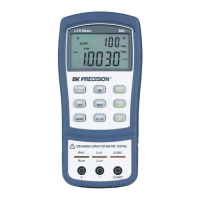47
Note: Alternatively, auto fetching mode can be disabled when a remote command is sent to the
instrument, turning it back into remote mode. In this event, the RMT indicator will appear on
the LCD display, and auto fetching will be disabled automatically. To re-enabled auto fetching
again in this state, first press the button once to exit out of remote mode and return to
local mode. Then, press the button once more to have it set to auto fetching mode again.
Command Protocols
Overview of Command Type and Format
All commands are entered in either the upper case or the lower case. There are two types of
the meter programming commands: IEEE 488 common commands and Standard Commands for
Programmable Instruments (SCPI). Some commands are device-specific to the meter. They are
not included in the version 1999.0 of the SCPI standard. However, these commands are
designed with the SCPI format in mind and they follow the syntax rules of the standard.
Common Command Format
The IEEE 488 standard defines the common commands as commands that perform
functions like reset and system query. Common commands usually come with the asterisk “*”
character, and may include parameters. Some examples of Common command like: *IDN?,
*GTL, *LLO.
SCPI Command Format and Query Format
The SCPI commands control instrument functions. A subsystem command has a
hierarchical structure that usually consists of a top-level (or root) keyword, one or more lower
level keywords, and parameters. The following example shows a command and its associated
query:
A. FUNCtion:impa L Select L as primary parameter
B. FUNCtion:impa? Return primary parameter
Function is a root level keyword with the second level keyword, impa, and L is the command
parameter. The query command ends with a question mark “?”.
Note: SCPI stems from IEEE488.1 and IEEE 488.2. Although the IEEE 488.2 standard addressed
some instrument measurements, it principally dealt with common commands and syntax or
data formats. Please refer to the IEEE488.2 and SCPI reference manual for more information.
Termination Character
A terminator is a character sent by a host, which identifies the end of a command string. A
valid terminator consists of two-byte data:
<CR> (Carriage Return, ASC (&H0D)) or <LF> (Line Feed, ASC(&H0A)) or <CR><LF>

